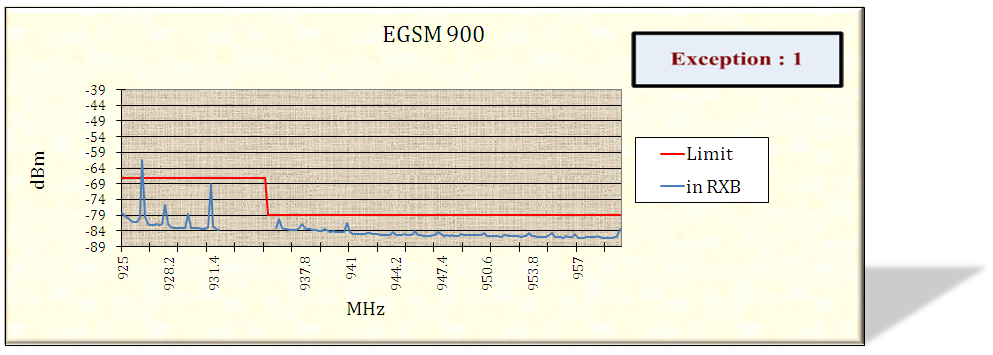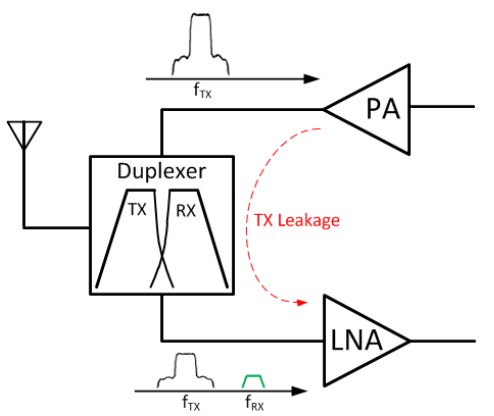GSM900 RF front-end building blocks and filtering
We build GSM900 RX/TX device (base station side) and we do not want to use duplexer (small device, large cavity filters and duplexers are not an option here). Instead we want to have separate RX and TX antennas.
Without any filtering our RX chain has small sensitivity, as the TX signal is leaking to the receiver. Putting antennas far apart helps, but is not enough. TX has up to 1W max (regulated).
So I have a few questions:
How much attenuation do I need between RX and TX ?
If I build RX chain as ANT-BPF-LNA-BPF-IQdemod: does it make sense to put BPF after ANT and before LNA? Will it not degrade NF too much?
Is it better to build the chain as:
ANT-LNA-BPF-LNA-BPF-IQdemod
I am assuming about 25dB attenuation in the BPF stop band (TriQuint part nr 856671)
How many of these filters do I need in the RX chain to get sensible separation between RX and TX ?
This is not an easy task and cannot be done without doing a system analysis, which includes characteristics of the receiver (as, in-band and out-band IP3, compression point, etc), and characteristics of the transmitter (as, ACLR and noise power in RX band). All of those, together with TX power and TX/RX isolation (conducted and radiated), will affect the final BS transceiver performances.
You have to put the filter in front of the LNA, otherwise you will never pass other spec requirements as out-of-band blocking test.
25dB might not be enough TX/RX isolation for a GSM base station, even it's a low power one. You have to look for something in 40dB range.
I wonder that why do you care Tx / Rx isolation so much ?
Because GSM is TDD, that is to say :
Tx : on Rx : off
Tx : off Rx : on
In theory, the Tx signal should not interfere Rx signal.
You have to read careful the GSM specs before doing this affirmation.
For almost 25 years since GSM network was implemented, the TX noise in RX band was a big challenge designing mobile phones.
The requirement is covered by the ETSI TS 145 005 and by 3GPP TS 45.005 mentioned in spurious emissions.
The receiver which is affected by the TX noise is a receiver of a different mobile phone situated in proximity place.
That proximity receiver is possible to receive a signal in the same time when the other mobile transmit.
Of course, what you said is right.
And I know the TX noise in RX band as well.
Besides, I have solved the issue for several times.
The issue is related to Tx matching, Tx SAW, DC-DC converter, XTAL, etc..

Nevertheless, according to what maniana said :
and we do not want to use duplexer
want to have separate RX and TX antennas
Without any filtering our RX chain has small sensitivity, as the TX signal is leaking to the receiver.
How much attenuation do I need between RX and TX ?
How many of these filters do I need in the RX chain to get sensible separation between RX and TX ?
It seems to be afraid of the Tx leakage issue.

However, GSM is TDD, not FDD.
There is no Tx leakage issue in GSM system.
Therefore, my affirmation :
In theory, the Tx signal should not interfere Rx signal.
is based on the situation merely within one device/system,
no other mobile phones situated in proximity place.
"In theory, the Tx signal should not interfere Rx signal"...but in real life it will interfere...so unfortunately, your statement is useless even you tried to go deep and deep in details, as usual.
Of course, in real life, Tx will interfere Rx signal which is within other phone.
But, even if in real life, Tx will NOT interfere Rx signal which is within its own phone.
Becasue GSM is TDD.
It is the reason why I wonder he/she cares Tx-Rx isolation so much.
Usually, when it comes to noise,
we should care the noise within a single device/system first.
If this is okay, and then, care the noise which is from outside device/system next.
